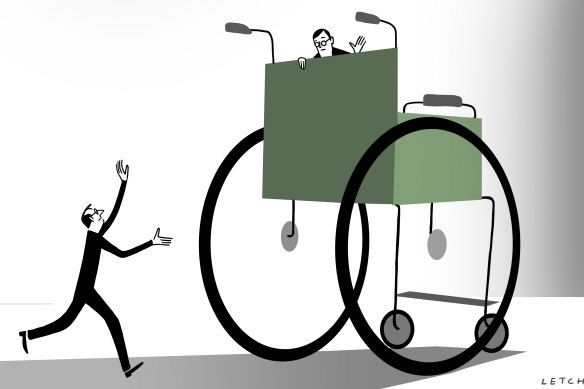This was published 3 months ago
Opinion
The best thing our pollies have done in decades is also the worst
Ross Gittins
Economics EditorWith the coming departure from politics of Bill Shorten, it’s time to talk about his former bouncing baby, and now obese adult, the National Disability Insurance Scheme. To his credit, his final act has been to put it on a strict diet.
The NDIS is one huge contradiction. Its introduction, in 2013, is Julia Gillard’s short-lived government’s greatest achievement, and Labor’s biggest extension of our welfare state since the introduction of Medicare in 1984.

Illustration: Simon Letch
Before the scheme began, people with physically and mentally disabilities received some help from state governments, but not a lot. To a great extent, the day-to-day care of people with a disability was left to their families.
Under the NDIS, however, the lives of hundreds of thousands of Australians living with a disability have been transformed. They’ve been given greater choice and control over the services and supports they receive. More of their needs are being met, with more of their care being provided by paid workers and less left to family members.
People with a disability are given a personalised “package” – a budget to cover the cost of specified goods and services they need. It sounds like a great improvement, and for many thousands of people it has been.
So, what’s the problem? It’s costing taxpayers far more than ever expected. It’s supporting more people than were expected to need help – more than 600,000 – and covering more forms of disability than intended.
The scheme’s cost is rising far faster than expected. It’s become the second-biggest item of spending in the federal budget, after the age pension. It’s expected to cost $49 billion this financial year, rising to $61 billion in three years’ time.
In 2014, the Medicare levy was increased from 1.5 per cent to 2 per cent of individuals’ taxable income to cover the cost of the scheme. This has proved wildly inadequate. The scheme’s cost has been rising by an astonishing 11 per cent a year.
This was clearly unsustainable. Since Labor returned to power in 2022, Shorten – the man who championed and initiated the scheme – has been struggling to control its ever-mounting cost, and thereby secure its future.
Last month, after reaching agreement with the states and gaining the support of the opposition, Shorten put through the Senate changes in the scheme’s rules intended to reduce the growth in its cost to a mere 8 per cent a year. The scheme will support fewer forms of disability and do more to limit overcharging by service providers. The states will be required to accept more responsibility.
As proof that costs are coming under control, Shorten has said the scheme ended last financial year about $600 million under budget. But how has such a well-intentioned scheme been such a disaster financially? It’s been a victim of the misguided crusade for smaller government – also known as neoliberalism – and its ideology that the public sector is always inefficient, whereas the private sector is always efficient.
The great misstep of our age has been the privatisation of many government-owned businesses and the “outsourcing” of taxpayer-funded services to private providers.
The proposal for a disability scheme was given a big tick by the Productivity Commission because a market could be established where private businesses competed to provide the goods and services to individuals using government money. This was ideology-based delusion. Governments can’t wave around the cash and create out of thin air a “market” that has any of the self-controlling properties described in economics textbooks.
Many people with disabilities can act like an ordinary consumer, making sure they get the good or service they need at a fair price, but many can’t, or don’t. Even where they have the understanding, they don’t have the same motivation to spend taxpayers’ money with the care they spend their own.
Where people’s disability means they’re unable to pick and choose, the government can pay someone to help them make their choices. But that adds to the cost. And who can be sure that person’s own interests don’t get in the way of them doing the best by their customer?
Even when most of these helpers do the right thing, are they highly motivated to ensure no more taxpayers’ money is spent than necessary? And that’s before you get to the actual providers of goods and services to people with disabilities. Since their prices are being paid from the bottomless pit of the government’s coffers, what’s to stop them providing more services than are strictly required, or padding out their prices, or even charging the government for services they didn’t provide?
When the feds took over responsibility for people with disabilities, the states happily stopped providing those limited services they were providing. So where they had, for example, employed providers in regional centres, they ceased to. Did a market of self-employed providers spring up to fill the vacuum? No, it didn’t.
The other hard lesson we’ve learnt is that the bureaucrats administering the scheme aren’t much good at detecting and preventing overservicing, overcharging and outright fraud.
Let’s hope that changes.
Ross Gittins is the economics editor.
Ross Gittins unpacks the economy in an exclusive subscriber-only newsletter. Sign up to receive it every Tuesday evening.